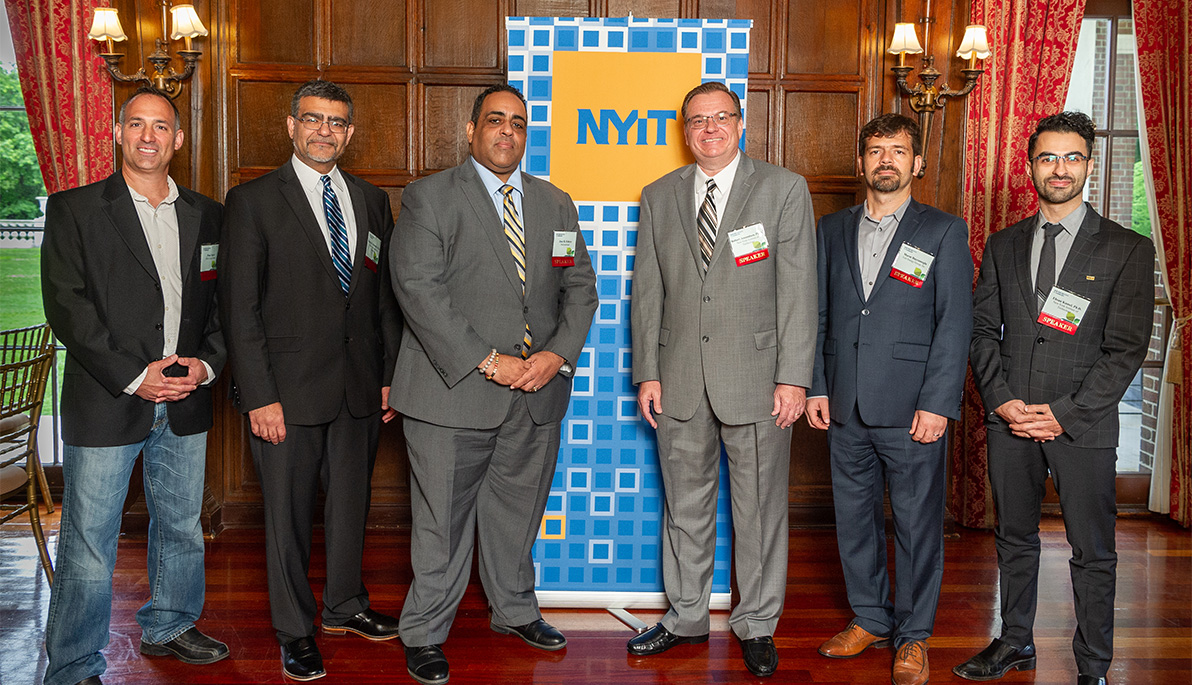News
Energy Conference Explores Safety, Comfort, and Sustainability in Facilities
June 18, 2019
Pictured from left: Peter Davie, Babak Beheshti, José R. Febres, Robert Amundsen, Murat Bayramoglu, and Ehsan Kamel.
On June 13, tech and sustainability experts gathered at the NYIT College of Engineering and Computing Sciences’ 14th Annual Energy Conference. This year’s theme, “Energy and Facilities: Safety, Comfort, Sustainability,” focused on advancements impacting and disrupting the energy sector. Babak Beheshti, Ph.D., dean of the College of Engineering and Computing Sciences, welcomed attendees and set the stage for the day’s discussions.
New York Institute of Technology demonstrated its commitment to building resilient communities throughout the day, with many of the presentations led by renowned alumni and faculty. Three of the seven presenters are graduates of the institution’s energy management program, which boasts alumni at Con Edison, National Grid, United Technologies, Johnson Controls, and Siemens, among others. In addition, faculty from the College of Engineering and Computing Sciences and NYIT School of Architecture and Design explored data-driven energy models and recommendations for urban development.
During the conference, experts touched on proposals for sustainable infrastructure, applications for renewable energy sources including biomass, and the development of energy policies and low-carbon technologies to address impending sustainability and climate change issues. Energy-related services are among the fastest-growing professions in the United States, with nearly seven million Americans employed in energy efficiency and related occupations. Presentations included:
- Sustainability, Reliability, and Critical Infrastructure
Peter M. Curtis (B.T. ’83, M.S. ’95), president and chief executive officer, PMC Group One, LLC, provided insight on the ways cyber attacks can impede everyday resources and sustainability. - Facility Condition Assessment Process — A Practical Overview
José R. Febres (M.S. ’12), P.E., D.Eng., technical compliance officer at the International Monetary Fund, shared insights on facility condition assessment, an analysis of deficiencies in a building’s critical systems to help develop improvement strategies. - Energy Audits, Retro-Commissioning, and Local Energy Laws
Murat Bayramoglu, CEM, CBCP energy efficiency engineer at Vert Energy Group, Inc., discussed New York City’s goals to reduce levels of greenhouse gas emissions by 30 percent by the year 2030. - NFPA 70E Requirements on Arc Flash Mitigation
Peter Davie, P.E. (B.S. ’97, M.S. ’18), principal staff engineer at PSEG Long Island, informed attendees about the dangers of arc flash injuries, which account for the majority of hospital admissions from electrical incidents, and explained standard procedures for mitigating arc flash. - The Role of Renewable Natural Gas in the Future Energy Mix
Devinder Mahajan, Ph.D., director of the Institute of Gas Innovation and Technology and professor of chemical and molecular engineering at Stony Brook University, discussed renewable energy policies and the development of low-carbon technologies to address sustainability and climate change issues. - The Impact of Building Envelope on Potential Energy Savings
Ehsan Kamel, Ph.D., assistant professor and director of the Energy and Green Technologies Laboratory at NYIT, focused on potential solutions to reduce building energy usage, noting that buildings account for approximately 40 percent of U.S. annual energy consumption. - Dynamic Energy Systems for Architecture and Design (streamed)
Marcella Del Signore, associate professor of architecture at the School of Architecture and Design, explained during a pre-recorded presentation how building exteriors can be transformed with complex shapes and dynamic systems. - Robert Amundsen, Ph.D., associate professor of energy management, director of the M.S. in Energy Management, and chair of the conference committee, delivered closing remarks.
Launched in 2005, the annual conference has gathered experts on climate change, renewable energy, resource management, and many other areas to address some of the world’s most pressing energy issues. Learn more about past conferences.

_Thumb.jpg)


